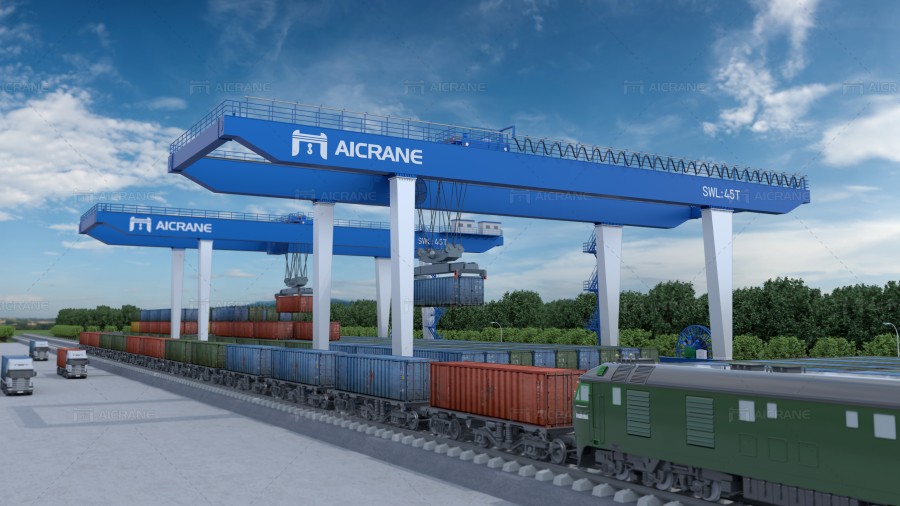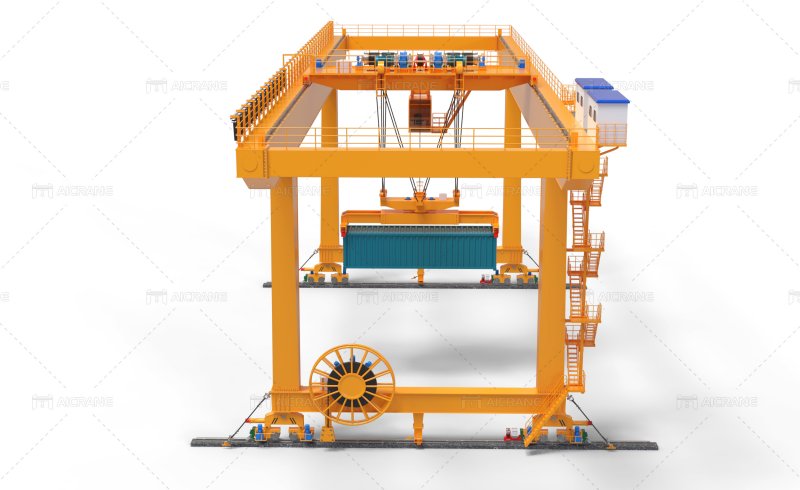In the dynamic world of logistics, the constant quest for efficiency, speed, and cost-effectiveness drives innovation and the adoption of advanced technologies. Among these, Rail Mounted Gantry (RMG) cranes stand out as pivotal tools transforming the logistics landscape. These cranes, which move on a fixed rail system, are indispensable in handling large volumes of cargo with precision and speed. They are particularly prominent in container terminals, rail yards, and intermodal operations, where they significantly enhance operational efficiency and throughput.
The Mechanics of Rail Mounted Gantry Cranes
Rail Mounted Gantry cranes are robust, high-capacity cranes designed to straddle rail tracks, allowing them to load and unload containers from trains, trucks, and storage areas. They consist of a main girder that spans the width of the tracks and support legs that run on rails. Equipped with a hoisting mechanism and a spreader, Rail mounted gantry crane can lift and transport heavy containers with ease.

The primary advantage of these cranes lies in their ability to handle containers swiftly and accurately. They operate on a fixed rail system, ensuring stability and reducing the risk of accidents. Their precision in stacking containers optimizes space utilization in storage yards, which is critical for managing the ever-increasing flow of goods in modern logistics.
Enhancing Efficiency and Productivity
One of the most significant impacts of RMG cranes in the logistics sector is the dramatic improvement in operational efficiency. These cranes can move containers much faster than traditional cranes or manual methods. This speed is essential in high-volume environments such as ports and intermodal terminals, where delays can lead to significant financial losses.
For instance, in container terminals, RMG cranes streamline the loading and unloading process, reducing the time ships spend docked at the port. This quick turnaround is crucial for shipping companies aiming to maintain tight schedules. In rail yards, RMG container cranes facilitate the swift transfer of containers between trains and trucks, enhancing the efficiency of intermodal operations and reducing dwell times.
Cost-Effectiveness and Scalability
RMG cranes also contribute to cost savings in logistics operations. Their high efficiency reduces labor costs and minimizes the need for additional equipment. Moreover, the scalability of RMG systems allows for incremental expansion as demand grows. Ports and terminals can invest in additional cranes or upgrade existing ones without overhauling the entire infrastructure.
The long-term cost benefits are substantial. By optimizing space and reducing handling times, RMG cranes lower operational costs and improve profitability. This cost-effectiveness makes them an attractive investment for logistics companies looking to enhance their competitive edge.

Technological Advancements and Automation
The integration of advanced technologies has further revolutionized RMG cranes, making them even more efficient and reliable. Modern RMG cranes are equipped with sophisticated control systems, including GPS and automated positioning software, which enhance precision and reduce human error. Automation is a key trend, with many RMG cranes now capable of fully automated operations.
Automated RMG cranes, controlled by central software, can perform tasks such as stacking, loading, and unloading with minimal human intervention. This automation not only speeds up operations but also enhances safety by reducing the risk of accidents caused by human error. Additionally, these systems can operate 24/7, significantly increasing productivity and throughput.
Environmental Benefits
RMG cranes also offer environmental benefits, aligning with the growing emphasis on sustainability in logistics. Electric-powered RMG cranes produce fewer emissions compared to diesel-powered equipment, contributing to lower carbon footprints. Their efficient operation also reduces energy consumption, further supporting environmental goals.
The use of RMG cranes can lead to more efficient land use in ports and terminals, as their ability to stack containers more densely reduces the required footprint for storage areas. This efficient space utilization is particularly important in urban areas where land is scarce and expensive.
Case Studies and Real-World Applications
Several ports and logistics hubs worldwide have successfully integrated RMG cranes into their operations, reaping significant benefits. For example, the Port of Rotterdam, one of the largest ports in Europe, employs RMG cranes to handle its vast container throughput efficiently. The automation and precision of these gantry cranes have enabled the port to maintain its status as a key global logistics hub.
In the United States, the Georgia Ports Authority has implemented RMG cranes in its Savannah terminal, one of the busiest container terminals in North America. The cranes have played a crucial role in accommodating the port’s rapid growth and improving its operational efficiency.
Conclusion
Rail Mounted Gantry cranes are revolutionizing the logistics sector by enhancing efficiency, reducing costs, and supporting sustainable practices. Their ability to handle large volumes of cargo quickly and accurately makes them indispensable in modern logistics operations. As technology continues to advance, the role of RMG cranes is set to become even more significant, driving further innovations and improvements in the industry. For logistics companies looking to stay ahead in a competitive market, investing in RMG cranes is a strategic move that promises substantial long-term benefits. To know more details about quality and robust gantry cranes, just click here https://aicranemachine.com/.